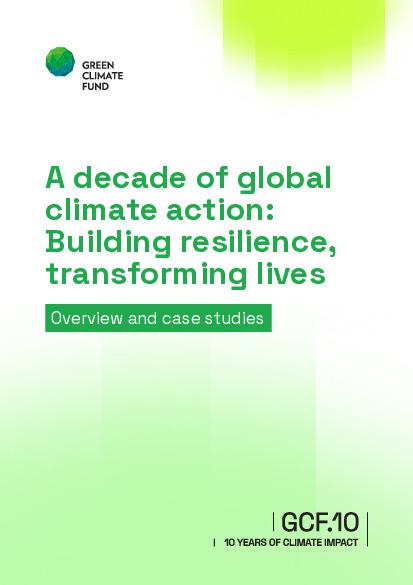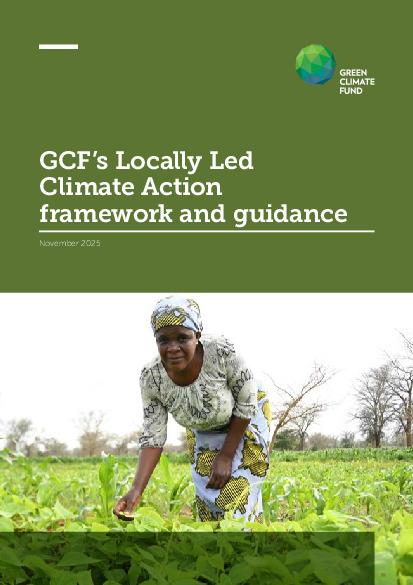Publications
The Green Climate Fund issues a range of publications for our direct and indirect stakeholders on a diversity of issues – for the general public to industry experts. Stay in tune with our mission and activities around the planet with the issues that speak to you.
Featured publications
GCF.10 Impact Report: Overview
A decade of global climate action: Building resilience, transforming lives
Read moreGCF’s Locally Led Climate Action framework and guidance
This document elaborates guidance on advancing good locally led practices through GCF modalities. Part 1 introduces GCF’s parameters and approach to devolution in the GCF business model and elaborates approaches for context-specific models. Part 2 provides step-by-step guidance for developing and structuring funding proposals in alignment with the parameters. A set of annexes cover Readiness, local, traditional and Indigenous knowledge, a related checklist and relevant examples from GCF portfolio.
Read moreCountry platforms for climate finance
This brochure describes GCF’s approach to country platforms, including an overview of the concept, the potential impact and the end-to-end support GCF can provide.
Read moreClimate investment planning and mobilization framework
The Green Climate Fund (GCF) and the NDC Partnership proudly launched the Climate Investment Planning and Mobilization Framework (Framework) to support countries in achieving national climate action. It aims to provide a common reference point fo
Read moreAnnual Progress Report 2024
This report describes the progress made by GCF to accelerate climate action for and by developing countries.
Read more
Multilateral Climate Funds Joint Results Report
November 2025
For the first time, the four Multilateral Climate Funds (Adaptation Fund, Climate Investment Funds, Global Environment Facility, Green Climate Fund) have come together to present a collective view of their impact, aggregating results against a critical set of common indicators of climate action, covering mitigation, adaptation, energy and technology, and nature. This milestone marks a significant step forward in their commitment to complementarity and coherence within the global climate finance...

GCF.10 Impact Report: Overview
November 2025
A decade of global climate action: Building resilience, transforming lives This impact report describes the impact of the Green Climate Fund’s work over the past ten years since the approval of its first projects in November 2015. It provides data on the implementation of GCF’s portfolio of over 300 projects, as well as evidence of impact on the ground. It explores, through a series of 10 case studies, how GCF is helping developing countries to adapt to climate change and to mitigate...

GCF’s Locally Led Climate Action framework and guidance
November 2025
GCF’s Locally Led Climate Action framework and guidance seeks to align the GCF, countries, accredited and executing entities, and partners on good locally led practices under existing access and funding modalities. Part 1 outlines GCF’s three parameters for locally led action: devolved decision-making and finance, local ownership and implementation, and sustainable local capacities. It elaborates approaches for developing context-specific financing and delivery models, explains how to approach...

GCF and Africa: Accelerating climate action together
September 2025
Empowering Africa-led adaptation and mitigation The Green Climate Fund's Africa brochure showcases the Fund's commitment to accelerating transformative climate action across the continent through country-led partnerships and strategic investments. The brochure outlines GCF's regional approach for 2025-2027, emphasising direct access financing, national climate platforms, and streamlined processes that enable African nations to access climate finance more efficiently. It highlights successful...

Social protection and inclusive climate action: A review of social protection for rural populations within Green Climate Fund projects
September 2025
Social protection is a powerful tool for delivering inclusive climate action, particularly in rural areas of low-income countries. This briefing paper presents the findings of a review of social protection for rural populations within the Green Climate Fund (GCF) portfolio. This analysis of 23 GCF-funded projects outlines both promising approaches and key challenges. Building on these insights, GCF should scale up the use of social protection, enhancing gender and inclusion efforts,...

Annual Progress Report 2024
September 2025
The urgency and severity of the climate crisis call for a response of commensurate speed, scale, and impact. The Green Climate Fund (GCF) is responding to the call. It is transforming to become more fit for purpose and deliver impact at scale as efficiently as possible, in line with its 50 by 30 vision and 2024-2027 Strategic Plan. In 2024, GCF made significant strides towards greater efficiency and impact. It undertook major reform initiatives to strengthen its programming and operations,...

Country platforms for climate finance
May 2025
This brochure describes GCF’s approach to country platforms, including an overview of the concept, the potential impact and the end-to-end support GCF can provide. In particular, it explains how the Readiness Programme can be used to support the establishment of country or regional platforms, and gives case studies from two countries.

GCF Water Project Design Guidelines - Part 1
May 2025
GCF Water Project Design Guidelines Part 1: Practical guidelines for designing water-climate resilient projects The GCF Water Project Design Guidelines provide a structured and programmatic approach to developing climate-resilient water projects. For water security projects for climate resilience, GCF uses innovative financing mechanisms to cover key domains such as water conservation, efficiency and reuse, hydrological observation, early warning and risk assessment, integrated water...

GCF Water Project Design Guidelines - Part 2
May 2025
GCF Water Project Design Guidelines Part 2: Applications of the practical guidelines for designing water-climate resilient projects in IWRM, CR-WASH, and drought and flood management The GCF Water Project Design Guidelines provide a structured and programmatic approach to developing climate-resilient water projects. For water security projects for climate resilience, GCF uses innovative financing mechanisms to cover key domains such as water conservation, efficiency and reuse, hydrological...

GCF Water Project Design Guidelines - Part 3
May 2025
GCF Water Project Design Guidelines Part 3: Practical guidelines for designing climate-resilient sanitation projects The GCF Water Project Design Guidelines provide a structured and programmatic approach to developing climate-resilient water projects. For water security projects for climate resilience, GCF uses innovative financing mechanisms to cover key domains such as water conservation, efficiency and reuse, hydrological observation, early warning and risk assessment, integrated water...

GCF in Brief: Locally Led Climate Action
April 2025
The Green Climate Fund is committed to ensuring climate finance reaches the most vulnerable and to scaling up direct access through Locally Led Climate Action (LLCA). LLCA enhances country ownership by grounding decisions in lived realities and empowering local actors to deliver sustainable, inclusive and context-specific climate solutions. This factsheet provides an overview of GCF's approach to Locally Led Climate Action and presents approved project examples that meaningfully engage local...

Evaluation of the outcomes and impact-level results of the Readiness and Preparatory Support Programme
March 2025
The Evaluation of the Outcomes and Impact-level Results of the Readiness and Preparatory Support Programme (RPSP or Readiness Programme) is the first Secretariat-led evaluation, guided by the GCF Evaluation Policy. It assesses the outcomes and impact-level results of the RPSP, with a focus on relevance, effectiveness, coherence, impact, and sustainability. It provides actionable recommendations to enhance the effectiveness and operationalization of the RPSP aligned with the new Readiness...

Climate investment planning and mobilization framework
March 2025
The Green Climate Fund (GCF) and the NDC Partnership proudly launched the Climate Investment Planning and Mobilization Framework (Framework) to support countries in achieving national climate action. It aims to provide a common reference point for countries and providers of climate finance and capacity support to navigate the steps involved in moving from planning and setting climate commitments (e.g., NDCs, NAPs, LT-LEDS) to identifying, prioritising and mobilising finance for the...

Debt for climate swaps: exploring avenues and opportunities
September 2024
The intersection of escalating public debt and the deepening climate crisis presents a dual challenge of paramount significance, particularly in Lower-Income Developing Countries and Small Island Developing States. Debt-for-Climate Swaps (DFCS) are an agreement between a sovereign and its creditors that reallocates a portion of ongoing debt obligations toward investments in climate action. Such transactions provide opportunities for countries to enhance both fiscal stability and climate...

Annual Report 2023
September 2024
2023 was a pivotal year for the Green Climate Fund (GCF), which saw several milestones: the culmination of its 2020-2023 programming period with a maturing portfolio of USD 13.5 billion invested in 243 projects across 129 developing countries; a record-breaking replenishment of USD 12.8 billion for its next programming period; and new leadership ushering in a new chapter for the Fund. 2023 was a pivotal year for the planet, the hottest on record, with heatwaves, floods, droughts, and...

How to financially incentivise well-designed climate projects
April 2024
The global development finance market has existed for decades, supported by globally accepted standards on project development and commensurate financial solutions. With climate change, there has been a focus on emissions reduction, bringing about a shift in project structuring and financing that consists of minor adjustments in the approach. These include emission-reduction protocols and calculations associated with financial incentives for clean-energy solutions. Since the devastating...

Programming guidelines for the Simplified Approval Process
December 2023
The SAP Programming Guideline, a vital element of our extensive GCF documentation suite, equips stakeholders with essential insights into the SAP's key objectives, policies, and a range of tools. Grounded in the GCF Investment Framework, the guideline delineates the Investment Criteria and the Fund's impact goals. It aids project developers in determining whether the SAP is their optimal funding avenue, guiding them through the nuances of proposal preparation and providing detailed steps for...

Reporting guidelines for the Simplified Approval Process (SAP)
December 2023
This guideline document responds to decision B.32/05 made by the GCF Board to develop guidance and templates for the Accredited Entities (AEs) on building a results-based monitoring and reporting system, based on the GCF integrated results management framework to simplify the annual performance report requirements and templates and accelerate disbursements. In particular, the primary aim of this guideline is to assist AEs in accurately and efficiently completing the SAP Annual Performance...

GCF Strategic Plan 2024-2027 overview
December 2023
Through decision B.36/13 the GCF Board adopted GCF’s Strategic Plan 2024-2027, setting out GCF’s major programming directions for GCF-2, capturing the ambition to deliver both strengthened climate results and greater access for developing countries as the world heads into a critical decade for global climate action. The Strategic Plan for 2024-2027 articulates how GCF will significantly enhance its support to developing countries, improve access, and strive to deliver the highest levels of...

GCF-SAP CREWS Scaling-up Framework for early warning
December 2023
The Scaling-up Framework was the result of a collaborative effort to develop scale-up financing modalities for early warning systems (EWS). It follows decisions, in 2022, by the Boards of both the Green Climate Fund (GCF) and the Climate Risk and Early Warning Systems (CREWS). The intention of the scaling-up Framework is to fast-track access to the GCF finance through its Simplified Approval Process (SAP) for countries with ongoing or recently completed CREWS projects. This Framework is...
